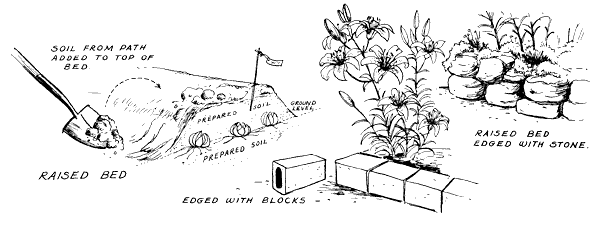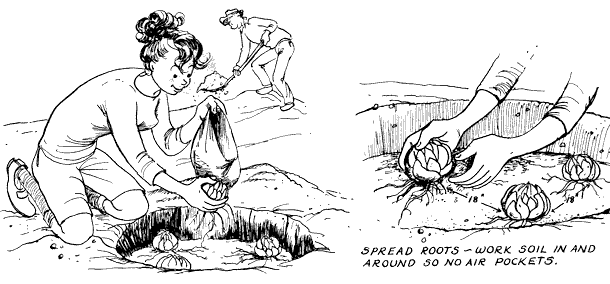Where will we plant our lilies?

Where will we plant our lilies? That seems like a silly question, doesn’t it? Why out in the garden, of course! Well, that is true, and no doubt you have some lovely spots all picked out and exciting “combinations” dreamed up. But before you dash out into the garden with your eager arms full of bulbs there is one thing you must know. Probably no other condition is more important to the well-being, even the very life of your lilies, than drainage. Lilies must have good drainage! It is Rule No.1 for success with lilies and also Rules Nos. 2, 3, 4 and 5! If you are going to choose a spot where water collects and stands, you might just as well take your hard-earned dollars out and plant them instead. You will have about as much chance of raising a crop!
Good drainage does not necessarily mean an intricate arrangement of drainage tiles, or doubled-digging. If you want to go to all that work, if your soil is heavy clay with a layer of hardpan beneath, it will certainly benefit your whole garden to provide this type of drainage insurance. Deep soil preparation has always been a good gardening practice. Lilies are not the only plants that appreciate good drainage and well-prepared soil, but if the thought of all that work discourages you, why not do one of the following.
Most lilies prefer full sun, but will perform well in partial shade. Martagon lilies are the most shade tolerant, and oriental lilies appreciate some shade in hotter climates.
Plant on a Slight Slope
This is the easiest way to insure rapid drainage of any surface water. Mulching around the stems or a ground cover will hold the good soil and keep it from washing away.
Raise the Bed
Lacking a natural slope, the next easiest method of providing good drainage is to raise the bed. Good soil can be heaped on top of the bed, thus obtaining deeper topsoil and a raised planting area. If it seems impractical to raise the whole garden due to the presence of already established material, separate planting “hills” or several smaller raised beds may be prepared.
How Deep?
You don’t have to worry too much about this except for Madonna Lilies (L. candidum). These must have no more than 1 inch of settled soil over the tops of the bulbs. Cover the others with about 3-4 inches of soil for small bulbs, and 4-6 inches for larger ones.
Scoop out a hole of the proper depth. It should be a generous hole with room to spread out all the roots comfortably. If planting in groups of three or more for a beautiful display, dig a hole large enough to accommodate the whole group. Ideally, bulbs should be at least 12 inches apart for small ones and 18 inches or more for large ones. Work the soil in around the bulbs and the roots, leaving no air pockets.
Water Immediately!
Just as soon as your bulbs are planted water them even if it is raining. Of course, you were careful when you planted your bulbs not to leave air pockets but by watering your plantings you will ensure that good damp soil comes in contact with all the roots. Every little root gets a nudge. “Come on grow!” There is often only a short time before the ground freezes and most growing ceases. The more growing and becoming established that the bulb does before freeze-up, the better able it will be to withstand the rigors of a long cold winter. Giving a newly planted clump a good soaking will be time well spent.
The Wisdom of Labeling
In the spring when the lily shoots emerge, they are very brittle and easily damaged, so it is wise to mark each bulb planted with a little stake and a label for the whole group. Then you won’t forget and step on them by mistake or chop their growing and flowering shoots off!
Spring Planting
There was a time when we were advised to plant lilies only in the fall. Many people believe that fall is still the best time to put in bulbs. However, with newly perfected storage methods, lily bulbs may be carried through the winter in excellent condition and arrive in the spring for planting as crisp and turgid as if freshly dug. It is also very difficult to receive adequately matured bulbs of Oriental lilies from commercial sources in time for fall planting in most areas. Plant as soon as the ground is workable in the spring, and in just a few weeks the fat “noses” of your lilies will come poking up. It won’t be any time at all before your garden is full of fragrant lilies!